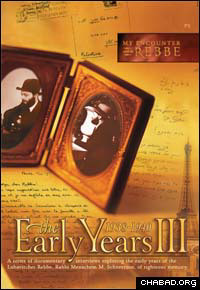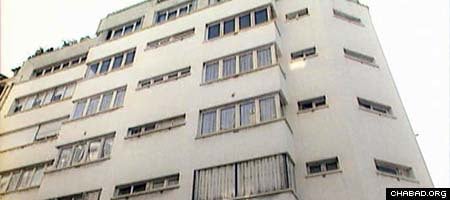To many followers, admirers and historians, much of the life of the Lubavitcher Rebbe, Rabbi Menachem Schneerson, of righteous memory, prior to his arrival in the United States in 1940 is a mystery. In a new documentary DVD featuring interviews and documents that cover the years 1938-1940, however, some details of this previously unexplored Paris chapter of the Rebbe's early years are brought to light.
The Rebbe spoke very little about his life and only occasionally alluded to anecdotes from his past, far preferring to focus on the life of his father, Rabbi Levi Yitzchak Schneerson, of righteous memory – who was the Chief Rabbi of Yekatrinoslav, Ukraine, before being exiled to a remote area in Kazakhstan by Soviet authorities.
Following the Rebbe's passing in 1994, however, Agudas Chassidei Chabad, the umbrella organization of Chabad-Lubavitch that was entrusted by the Rebbe with the care of his writings, began releasing notebooks of the Rebbe's dating from 1928 to 1950. The notebooks, which the Rebbe kept in his office at Lubavitch World Headquarters in the Crown Heights section of Brooklyn, N.Y., contained hundreds of 5.5 by 8.5 inch sheets crammed with small text. They referenced hundreds of sources among Jewish books, ranging from the Talmud and its commentaries to the Zohar and its commentaries. They also referred to various scientific theories and achievements.
The notebooks were instrumental in gathering information for the historic DVD.
Bernard Lax, whose parents hosted the previous Lubavitcher Rebbe, Rabbi Yosef Yitzchak Schneersohn, of righteous memory, many times during his visits in Paris, provided some information about the times the Rebbe, then just the son-in-law of the previous Lubavitcher Rebbe, visited the Lax home when he was in his late teens.
"Every day he went to the Pletzel – the Jewish district – which had Rue D'Rosei [and] two shteiblach," or synagogues, said Lax, 90 and retired in London, in an interview with Jewish Educational Media (JEM), producers of the DVD. "Number 17 was Chabad and 25 was everything, what you want," meaning that all different kind of Jews prayed there.
The Rebbe "hardly ever went to [the synagogue on] 17, and my opinion is because he didn't want the kavod [honor] among Chabad Chasidim [which] they would have given him," added Lax, who also observed that the Rebbe "shunned every kavod."
This apparent rejection of unnecessary honor was evident in the Rebbe's involvement at times as secretary to his father-in-law and in his public activities and publications. For example, some have postulated that the Rebbe deliberately used a script much more difficult to decipher when signing letters as the previous Rebbe's secretary than he did after he became Rebbe.
As a result of these examples and others, the Rebbe's life in many ways still remains a mystery. However, in a last-minute effort to preserve the anecdotes and stories of those acquainted with the Rebbe, Rabbi Zalman Shmotkin, now the executive director of Chabad.org, began an initiative to interview acquaintances of the Rebbe and record details of his life. The project was later continued by his brother, Rabbi Elkanah Shmotkin and his team at JEM, resulting in the "Early Years" series. The newest DVD is titled "The Early Years III."
While the interviews share anecdotes of the Rebbe's life based on the memories of those that experienced them, or stories that they related to their children, the newest DVD backs up people's accounts with documentary evidence.
The Documents

From various notebooks of dissertations, letters and anecdotes, it is clear that the Rebbe dedicated a great portion of his day engrossed in Torah study.
"[My father] studied at the Sorbonne and he met [the Rebbe]," said Moshe Zev Reitzer, whose father was studying to become a pharmacist. "My father was in awe of him. The Rebbe would come straight to the lectures; and he didn't speak with anyone. He would come in, and as soon as the lecture ended, he would leave. He was extremely [cautious], my father told me, to guard his eyes not to see anything impermissible. He spoke to almost no one, and if he did say something, it was very brief."
An 11 page document crammed with text that Rebbe penned in 1939 at the request of his father-in-law contains an in-depth analysis of the menorah, the candelabra that stood in the Holy Temple in Jerusalem. In the work, the Rebbe dissects a complicated and difficult difference of opinion among sages regarding which direction the menorah faced in the Temple. The dispute has implications for how the candles on the menorah were aligned.
Following its discovery, the text was deciphered by three scholars who worked full-time for four months, according to Rabbi Chaim Shaul Brook, who is part of the editorial team that worked on publishing the notebooks. The team wrote a commentary on the text, including extensive footnotes. During 1997, the document was published weekly by Kehot Publication Society in 21 installments and later in a 150-page book.
While most do not know for certain where the Rebbe received texts upon which he could base his work, Lax provided a potential answer.
"I once met him, I had to translate something from Greek to French," related Lax, who said that he had to go to the Sainte-Geneviève library in the vicinity of the Sorbonne to work on his translation. The library owns handwritten editions of the Jerusalem Talmud, original manuscripts by Maimonides and other Jewish texts.
"The Rebbe was sitting not far from me," said Lax. "He spent a lot time there on the research."
Officials at JEM were quick to portray the DVD as a glimpse into the Rebbe's life, instead of a full-blown documentary. They said that video leaves open many avenues for further exploration.
While the DVD provides valuable information about the Rebbe's early years as a result of such previously concealed information, it leaves much more still to be discovered, said Yechiel Cagen, who directed the production.
"At a screening," said Cagen, by way of example, "there was an individual who has valuable information about the Rebbe's life [and] who, as of yet, is not comfortable to share his personal stories on video."






Start a Discussion